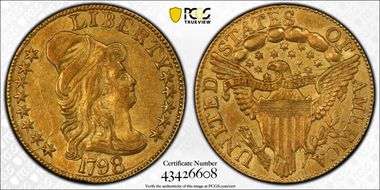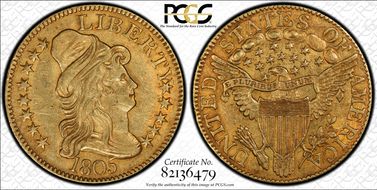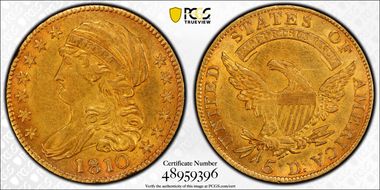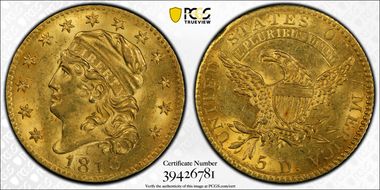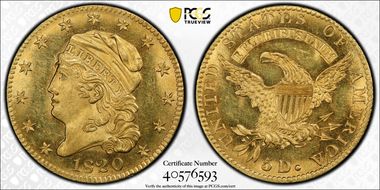Pumpkin Collection - SCARSDALE COIN 的钱币相册
1795 $5 Small Eagle, BD-10, R.5, AU58 PCGS. Ex: Harry W. Bass, Jr. Collection. Bass-Dannreuther Die State c/b. This is the BD-10 plate coin in the Bass-Dannreuther reference. While the BD-10 variety is reasonably available from an estimated 40 to 50 surviving examples, few of those can match the quality of this near-Mint coin. The BD-10 die pair shares its obverse with the BD-8 and BD-9 varieties, easily identified by its crowded date numerals squeezed into the small space between Liberty's lowest curl and down-sloping drapery. Obverse die lapping removes die clashing visible on BD-9, and the obverse stars appear somewhat smaller than usual as a result. Four berries decorate the reverse wreath -- two left and two right, distinguished by the inside-right berry lower than any other Small Eagle reverse. Brilliant yellow-gold surfaces are lightly abraded with a hint of high-point wear from brief circulation. There are no heavy marks, although the lower-right reverse rim shows Mint-made adjustment marks that eliminate the dentils in that area. Considerable prooflike flash remains within the outer legends. Both the D in UNITED and the second T in STATES are markedly recut and serve as interesting diagnostics, not mentioned in the Harry Bass commentary or the Dannreuther text. The finest BD-10 Small Eagle five dollar gold piece appeared in our April 2015 Central States Platinum Night auction, an amazing MS64 Prooflike coin certified by NGC. While that coin remains head and shoulders above the two Mint State coins, the present Harry Bass Core Collection coin claims a leading role among near-Mint examples and is notably impressive in its own right. Early half eagle enthusiasts are sure to take note.
1802/1 $5 BD-2, High R.4, VG10 PCGS. CAC. Bass-Dannreuther Die State c/c with a cud over the F in OF. Rich peach-gold toning deepens near the borders of this circulated Heraldic Eagle five. The wings and portrait exhibit substantial wear, but the date and other peripheral legends are bold, and there are no mentionable marks. Presently the only VG10 1802/1 half eagle with a CAC seal (1/18).
1812 $5 MS 62 PCGS. Wide 5D. Ex: Bass Collection. B. 1-B. Miller-118, R.3. Sold as lot 801 in the second offering of Bass coins, where it was described as, "Sharply struck with very attractive light orange-gold lustre. Minor surface marks do not distract from the aesthetic appeal. Heavy obverse and reverse clash marks. No die cracks are noted." Ex: Bass II (Bowers and Merena, 10/99), lot 801, where it realized $8,912.50; purchased by Bass from A-Mark Coin Co., March 16, 1978.
1813 $5 BD-1, R.2, MS62 PCGS. CAC. Ex: King Farouk. Bass-Dannreuther Die State a/a. The 1813 is the first issue of the Capped Bust Left type, which, as a whole, was subject to extensive hoarding and melting as gold was driven out of circulation. This date was saved to a much greater extent than later issues, with 450 to 650 survivors of the BD-1 die pair alone. BD-1 representatives are distinguished from their BD-2 counterparts by the placement of the first S in STATES over the right side of the E on the ribbon below. The present example was sold as part of the King Farouk holdings in 1954. Maurice Storck attended that famous sale and likely purchased the coin either directly at auction or soon after from one of the other dealers in attendance. Orange accents appear over lustrous yellow-gold surfaces that show only minor disturbances in the fields. The overall impression is bold with minor roller marks on the portrait and lower obverse border. Eye appeal is tremendous. A perfect type coin with a great provenance. Ex: King Farouk; Palace Collections of Egypt (Sotheby's, 2/1954), lot 233. From The Maurice Storck Collection.
1813 $5 BD-1, R.2, MS62 PCGS. CAC. Ex: King Farouk. Bass-Dannreuther Die State a/a. The 1813 is the first issue of the Capped Bust Left type, which, as a whole, was subject to extensive hoarding and melting as gold was driven out of circulation. This date was saved to a much greater extent than later issues, with 450 to 650 survivors of the BD-1 die pair alone. BD-1 representatives are distinguished from their BD-2 counterparts by the placement of the first S in STATES over the right side of the E on the ribbon below. The present example was sold as part of the King Farouk holdings in 1954. Maurice Storck attended that famous sale and likely purchased the coin either directly at auction or soon after from one of the other dealers in attendance. Orange accents appear over lustrous yellow-gold surfaces that show only minor disturbances in the fields. The overall impression is bold with minor roller marks on the portrait and lower obverse border. Eye appeal is tremendous. A perfect type coin with a great provenance. Ex: King Farouk; Palace Collections of Egypt (Sotheby's, 2/1954), lot 233. From The Maurice Storck Collection.
The 1827 half eagle is a well-known melt rarity with an estimated three dozen known from a mintage which is estimated to be 24,913 coins. This issue saw little circulation, and the majority of the survivors are Uncirculated, including a few Gems. It is difficult to imagine a more aesthetically appealing example for the grade, with both the obverse and the reverse showing very deep natural orange-gold colors which flash reddish-gold hues when the coin is tilted towards a light source. There is no real wear seen on either side and this coin has what used to be referred to as “cabinet friction” on the high spots. One very thin scratch in the left obverse field is barely noticeable with the naked eye, and this is an exceptionally attractive coin.
The 1827 half eagle is a well-known melt rarity with an estimated three dozen known from a mintage which is estimated to be 24,913 coins. This issue saw little circulation, and the majority of the survivors are Uncirculated, including a few Gems. It is difficult to imagine a more aesthetically appealing example for the grade, with both the obverse and the reverse showing very deep natural orange-gold colors which flash reddish-gold hues when the coin is tilted towards a light source. There is no real wear seen on either side and this coin has what used to be referred to as “cabinet friction” on the high spots. One very thin scratch in the left obverse field is barely noticeable with the naked eye, and this is an exceptionally attractive coin.
Breen-6509, Second Head, Large Date McCloskey 4-C, R.3. The reverse is surprisingly well struck, while the obverse has only a hint of softness of definition on the left side stars. The portrait has just a trace of friction, and the olive-gold surfaces have considerable satiny luster.





















